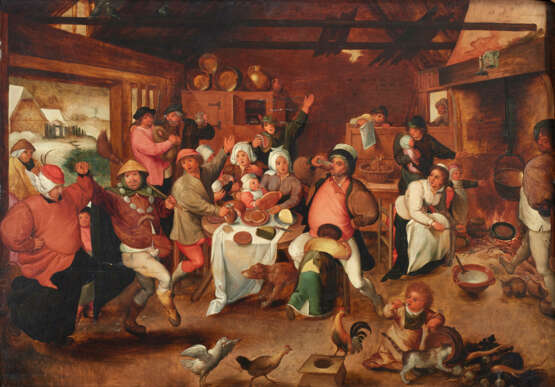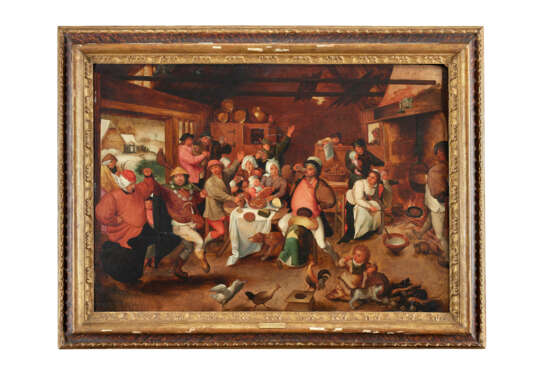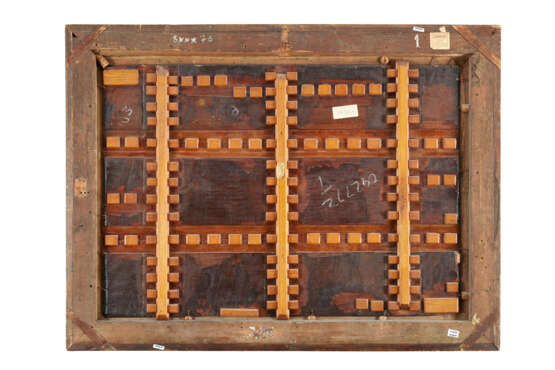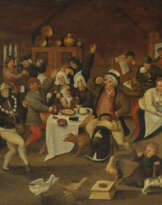ID 974988
Lot 17 | MARTEN VAN CLEVE (ANVERS VERS 1527-VERS 1581)
Estimate value
€ 250 000 – 350 000
La fête des Rois
huile sur panneau
74 x 106 cm. (29 1/8 x 41 3/4 in.)
Provenance
Ancienne collection de Robert de Montesquiou (1855-1921), Paris (selon G. Hulin de Loo, 1907, op. cit. infra).
Galerie de Paris ; d'où acquis en 1976 (comme 'Pierre Brueghel le Jeune et atelier').
Literature
G. Hulin de Loo, Catalogue raisonné de l'oeuvre peint de Bruegel, Bruxelles, 1907, p. 378, sous le n°22.
G. Marlier, Pierre Brueghel le Jeune, Bruxelles, 1969 (édition posthume mise au point et annotée par J. Folie), p. 356, sous le c).
M. Diaz Padron, 'La Obra de Pedro Brueghel el joven en Espana', Archivo Español de Arte, 1980, LIII, p. 311.
K. Ertz, Pieter Brueghel der Jüngere (1564-1637/38). Die Gemälde mit Kritischem Oeuvrekatalog, Lingen, 1988/2000, I, p. 535, n°F 584 (comme 'attribué à Pierre Brueghel le Jeune').
Post lot text
MARTEN VAN CLEVE, THE KING DRINKS, OIL ON PANEL
This painting depicts the feast of Epiphany, celebrated either on 6 January – the thirteenth day after Christmas – or on the preceding evening (Twelfth Night). After returning from church, the company would gather for a large meal, at the start of which one of those present would be chosen as king by casting lots or by serving cakes, one of which included a bean, the discoverer of which being designated king (hence the alternative name for the theme in artistic depictions: The Bean King). The king would then be given a paper crown and would organize the members of the court: typically a queen, jester, cook, musician, master of ceremonies, taster and porter. The highlight of the evening was the moment the king lifted the glass to take the first sip, at which the company would shout as loudly as possible "The king drinks!", after which the main celebrations would begin.
There has long been debate as to who, exactly, first developed this popular composition. It was traditionally believed that Marten van Cleve (c. 1587-c. 1581) invented it and that the younger Pieter Brueghel II (1564-1637/1638) produced copies after a lost van Cleve prototype. However, in his monograph on Pieter II, Klaus Ertz proposed that the present compositional type is an invention by the younger artist which is only loosely based on van Cleve (K. Ertz, Pieter Brueghel der Jüngere (1564-1637/38). Die Gemälde mit Kritiscjem Oeuvrekatalog, Lingen, I, 1988/2000, pp.523-533). There, the author lists three examples as being fully attributable to Pieter II (K. Ertz, 1988/2000, op. cit., n°576-578) – a fourth autograph painting, dated 1620, has since resurfaced (anonymous sale, Christie’s, London, 6 December 2011, lot 15) – and additional works are recorded in earlier documents or known only from photographs. Though the compositions of the various versions are ostensibly the same, those which Ertz gives without reservation to Pieter II all exclude the spilled vegetables seen here in the lower right corner. This motif is found nowhere in Brueghel’s oeuvre but does appear in paintings by van Cleve, among them versions of The Farm Visit which are today in the Philadelphia Museum of Art (inv. no. 424) and the Städel Museum (inv. no. 1931), Frankfurt.
Dr. Klaus Ertz again took up the question of the origins of the composition in his 2014 catalogue raisonné on Marten van Cleve. There, he reversed his earlier opinion that the idea was devised by Pieter II, instead giving it to the elder artist (K. Ertz, Marten van Cleve, 1524-1581: Kritischer Katalog der Gemälde und Zeichnungen, Lingen, 2014, p.61). According to this most recent line of reasoning, Pieter II only began to produce paintings of this subject matter based on van Cleve’s designs after 1616. Nearly two decades later, van Cleve’s festive composition likewise captured the attention of the greatest of all Flemish painters – Sir Peter Paul Rubens (1577-1640) – who reworked an unfinished copy after it as one of three depictions of popular winter festivals, which also included The Feast of Saint Martin and The Procession of the Lame Men (see K. Belkin, in A House of Art: Rubens as a Collector, [exh. cat.], Antwerp, 2004, p.231).
At the time of his publication, Ertz identified seven paintings of this composition by van Cleve (K. Ertz, 2014, op. cit., pp.182-185, n°100-106). The present painting, previously unknown to Ertz, constitutes an important recent addition to his oeuvre. Among van Cleve’s hallmarks as a painter, so evident in the present painting, are faces with rounded noses and thick lips. Ertz rightfully contends that, in characterizing his figures in this manner, van Cleve marks them as simpletons whose concerns hardly extend beyond the revelatory atmosphere of their rustic domestic interior (K. Ertz, 2014, op. cit., p.18).
We would like to thank Dr. Klaus Ertz for confirming the attribution of our painting to Marten van Cleve based on an examination of a photographic reproduction of the work.
| Artist: | Marten van Cleve I (1521 - 1581) |
|---|---|
| Applied technique: | Oil on panel |
| Art style: | Old Masters |
| Genre: | Genre art |
| Place of origin: | Belgium, Western Europe, Europe |
| Auction house category: | Paintings |
| Artist: | Marten van Cleve I (1521 - 1581) |
|---|---|
| Applied technique: | Oil on panel |
| Art style: | Old Masters |
| Genre: | Genre art |
| Place of origin: | Belgium, Western Europe, Europe |
| Auction house category: | Paintings |
| Address of auction |
CHRISTIE'S 9 Avenue Matignon 75008 Paris France | ||||||||||||||
|---|---|---|---|---|---|---|---|---|---|---|---|---|---|---|---|
| Preview |
| ||||||||||||||
| Phone | +33 (0)1 40 76 85 85 | ||||||||||||||
| Fax | +33 (0)1 40 76 85 86 | ||||||||||||||
| Conditions of purchase | Conditions of purchase | ||||||||||||||
| Shipping |
Postal service Courier service pickup by yourself | ||||||||||||||
| Payment methods |
Wire Transfer | ||||||||||||||
| Business hours | Business hours
|











